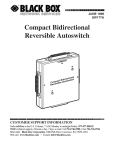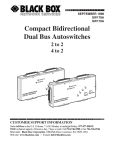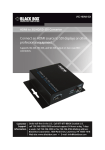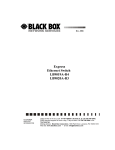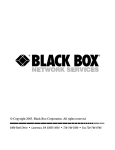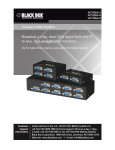Download Black Box PI125A-R2 Specifications
Transcript
© Copyright 2001. Black Box Corporation. All rights reserved. 1000 Park Drive • Lawrence, PA 15055-1018 • 724-746-5500 • Fax 724-746-0746 JUNE 2001 PI125A-R2 PI126A Serial↔Parallel Converter IV Serial↔Parallel Converter for HP® DeskJet® Printers EL RALLIV ↔PA ALNV ERTER SERICO CUSTOMER SUPPORT INFORMATION Order toll-free in the U.S. 24 hours, 7 A.M. Monday to midnight Friday: 877-877-BBOX FREE technical support, 24 hours a day, 7 days a week: Call 724-746-5500 or fax 724-746-0746 Mail order: Black Box Corporation, 1000 Park Drive, Lawrence, PA 15055-1018 Web site: www.blackbox.com • E-mail: [email protected] TRADEMARKS/CE NOTICE Trademarks Used In This Manual Black Box and the logo are registered trademarks of Black Box Corporation. Centronics is a registered trademark of GENICOM Corporation. DeskJet and HP are registered trademarks of HewlettPackard. IBM is a registered trademark of IBM Corporation. Any other trademarks mentioned in this manual are acknowledged to be the property of the trademark owners. European Union Declaration of Conformity The CE symbol on the equipment indicates that it is in compliance with the Electromagnetic Compatibility (EMC) directive and the Low Voltage Directive (LVD) of the Union European (EU). 1 SERIAL↔PARALLEL CONVERTERS FEDERAL COMMUNICATIONS COMMISSION AND INDUSTRY CANADA RADIO FREQUENCY INTERFERENCE STATEMENTS This equipment generates, uses, and can radiate radio frequency energy and if not installed and used properly, that is, in strict accordance with the manufacturer’s instructions, may cause interference to radio communication. It has been tested and found to comply with the limits for a Class A computing device in accordance with the specifications in Subpart J of Part 15 of FCC rules, which are designed to provide reasonable protection against such interference when the equipment is operated in a commercial environment. Operation of this equipment in a residential area is likely to cause interference, in which case the user at his own expense will be required to take whatever measures may be necessary to correct the interference. Changes or modifications not expressly approved by the party responsible for compliance could void the user’s authority to operate the equipment. This digital apparatus does not exceed the Class A limits for radio noise emission from digital apparatus set out in the Radio Interference Regulation of Industry Canada. Le présent appareil numérique n’émet pas de bruits radioélectriques dépassant les limites applicables aux appareils numériques de classe A prescrites dans le Règlement sur le brouillage radioélectrique publié par Industrie Canada. 2 NOM STATEMENT NORMAS OFICIALES MEXICANAS (NOM) ELECTRICAL SAFETY STATEMENT INSTRUCCIONES DE SEGURIDAD 1. Todas las instrucciones de seguridad y operación deberán ser leídas antes de que el aparato eléctrico sea operado. 2. Las instrucciones de seguridad y operación deberán ser guardadas para referencia futura. 3. Todas las advertencias en el aparato eléctrico y en sus instrucciones de operación deben ser respetadas. 4. Todas las instrucciones de operación y uso deben ser seguidas. 5. El aparato eléctrico no deberá ser usado cerca del agua—por ejemplo, cerca de la tina de baño, lavabo, sótano mojado o cerca de una alberca, etc. 6. El aparato eléctrico debe ser usado únicamente con carritos o pedestales que sean recomendados por el fabricante. 7. El aparato eléctrico debe ser montado a la pared o al techo sólo como sea recomendado por el fabricante. 8. Servicio—El usuario no debe intentar dar servicio al equipo eléctrico más allá a lo descrito en las instrucciones de operación. Todo otro servicio deberá ser referido a personal de servicio calificado. 9. El aparato eléctrico debe ser situado de tal manera que su posición no interfiera su uso. La colocación del aparato eléctrico sobre una cama, sofá, alfombra o superficie similar puede bloquea la ventilación, no se debe colocar en libreros o gabinetes que impidan el flujo de aire por los orificios de ventilación. 3 SERIAL↔PARALLEL CONVERTERS 10. El equipo eléctrico deber ser situado fuera del alcance de fuentes de calor como radiadores, registros de calor, estufas u otros aparatos (incluyendo amplificadores) que producen calor. 11. El aparato eléctrico deberá ser connectado a una fuente de poder sólo del tipo descrito en el instructivo de operación, o como se indique en el aparato. 12. Precaución debe ser tomada de tal manera que la tierra fisica y la polarización del equipo no sea eliminada. 13. Los cables de la fuente de poder deben ser guiados de tal manera que no sean pisados ni pellizcados por objetos colocados sobre o contra ellos, poniendo particular atención a los contactos y receptáculos donde salen del aparato. 14. El equipo eléctrico debe ser limpiado únicamente de acuerdo a las recomendaciones del fabricante. 15. En caso de existir, una antena externa deberá ser localizada lejos de las lineas de energia. 16. El cable de corriente deberá ser desconectado del cuando el equipo no sea usado por un largo periodo de tiempo. 17. Cuidado debe ser tomado de tal manera que objectos liquidos no sean derramados sobre la cubierta u orificios de ventilación. 18. Servicio por personal calificado deberá ser provisto cuando: 4 A: El cable de poder o el contacto ha sido dañado; u B: Objectos han caído o líquido ha sido derramado dentro del aparato; o C: El aparato ha sido expuesto a la lluvia; o D: El aparato parece no operar normalmente o muestra un cambio en su desempeño; o E: El aparato ha sido tirado o su cubierta ha sido dañada. TABLE OF CONTENTS Contents 1. Specifications ..............................................................6 2. Introduction ................................................................8 2.1 Description ..........................................................8 2.2 Features................................................................8 3. Configuration and Installation ................................10 3.1 Configuration Switches ....................................10 3.2 Installation ........................................................14 4. Reading the LED ......................................................15 5. Troubleshooting ........................................................16 5 SERIAL↔PARALLEL CONVERTERS 1. Specifications Data Rates — 300, 600, 1200, 2400, 4800, 9600, 19,200, 38,400 bps Indicators — LED displays status and operating condition Interface — EIA RS-232 async serial (autosensing DTE/DCE) and IBM PC parallel Connectors — (1) DB25M, (1) DB25F Data Format — 7 or 8 bits; 1 or 2 stop bits; even, odd, or no parity Temperature Range — 32 to 140°F (0 to 60°C) Altitude — Up to 10,100 feet (3078 m) Humidity — 5 to 95%, noncondensing Power — No external power required; uses power from the RS-232 interface 6 CHAPTER 1: Specifications Size — 3.4"H x 1.3"W x 0.8"D (8.7 x 3.3 x 2 cm) Weight — 2 oz. (57 g) 7 SERIAL↔PARALLEL CONVERTERS 2. Introduction 2.1 Description The Serial↔Parallel Converters automatically convert RS-232 serial data to parallel data format and vice versa, in one direction at a time. Incorporating advanced microprocessor technology, they are able to automatically sense and select parallel and serial modes, as well as DCE/DTE modes. Requiring no AC power, these Converters support serial data rates to 38.4 kbps. For easy configuration, the Converters feature a convenient set of external configuration switches. These accessible configuration switches allow you to control baud rate, parity, word length, and flow control. An easy-to-read LED indicator displays status and operating condition. Housed in an ultra-miniature ABS plastic case, each Converter comes equipped with a DB25 female connector on the serial side and a DB25 male connector on the parallel side. 8 CHAPTER 2: Introduction 2.2 Features • Converts parallel data to serial data and vice versa. • Automatically selects parallel-to-serial and serial-to-parallel operation. • Automatically selects DCE/DTE modes. • Serial data rates to 38,400 bps. • No AC power required. • Supports both software and hardware flow control. • A five-state LED monitors status and diagnostics. • External configuration switches. • Ultra-miniature size. 9 SERIAL↔PARALLEL CONVERTERS 3. Configuration and Installation The Converter is simple to install and extremely reliable. The following instructions will help you set up and install your converter properly. If you have any questions, please call Black Box Technical Support at 724-746-5500. 3.1 Configuration Switches The Converters each use a set of eight external DIP switches (see Figure 3-1) that allow configuration to a wide range of applications. Because all eight switches are in one externally accessible DIP-switch package, you don’t need to open the case for configuration. The configuration switches allow you to select data rates, parity, word length, and flow control. This section describes all switch locations, positions, and functions. 10 CHAPTER 3: Configuration and Installation Figure 3-1. The location of the configuration switches. OFF DHS-8 1 2 3 4 5 6 7 8 Figure 3-2. The miniature configuration switch package. 11 SERIAL↔PARALLEL CONVERTERS The Converters use a miniature configuration switch package. To configure your unit, use a small screwdriver and gently push each switch to its proper setting. The ON and OFF positions are shown in Figure 3-2. Default settings (noted with an asterisk) for the DIP switches are shown in the table on the following page. Set up the Converter by selecting the appropriate DIP-switch settings for your application. 12 CHAPTER 3: Configuration and Installation Position 1 2 3 4 5 OFF ON OFF ON ON OFF OFF ON OFF OFF ON OFF ON OFF ON ON OFF* OFF OFF ON OFF ON ON ON 6 7 OFF ON ON OFF ON OFF ON OFF OFF OFF ON ON ON OFF OFF ON 8 Flow Control Hardware Software OFF* ON LED Enabled Disabled ON* OFF Parity/D. Bits/ S. Bit None/8/1 Odd/8/1 Even/8/1 None/7/2 Odd/7/2 Even/7/2 Odd/7/1 Even/7/1 D. Rate (bps) 300 600 1200 2400 4800 9600 19200 38400 ON ON OFF ON ON OFF* OFF OFF *Default setting. 13 SERIAL↔PARALLEL CONVERTERS 3.2 Installation The Converter is very simple to install. Once you have configured the DIP switches, just plug your Converter into a standard cable and you’re ready to go. Figure 3-3 shows the proper connections. Figure 3-3. Typical installation. 14 CHAPTER 4: Reading the LED 4. Reading the LED Once your Converter is properly configured and installed, it should operate transparently—as if it were a standard cable connection. Operating power is derived from the RS-232 data and control signals; there is no “ON/OFF” switch. The Converter indicates data activity by blinking. When the Converter has another message to report, the LED blinks according to the codes in Table 4-1 below. Table 4-1. LED Codes ••-•—••-•— Computer is sending data •—•—•— Serial device is connected; computer is not sending data ••—••— Both serial and parallel devices are connected; computer is not sending data •-•—•-•— Printer not ready, data held in buffer ••••—•••• Computer ignoring flow control, data lost Key: • — Blink Short pause Long pause 15 SERIAL↔PARALLEL CONVERTERS 5. Troubleshooting If your Serial↔Parallel Converter seems to be malfunctioning, do not attempt to alter or repair the unit. Contact Black Box Technical Support at 724-746-5500. Before you do so, make a record of the history of the problem. We will be able to provide more efficient and accurate assistance if you have a complete description, including: • The nature and duration of the problem. • When the problem occurs. • The components involved in the problem. • Any particular application that, when used, appears to create the problem or make it worse. If you need to transport or ship your Converter: • Carefully package it. We recommend that you use the original container. • If you’re shipping the Converter back to Black Box, call Technical Support to get a Return Materials Authorization (RMA) number. 16 NOTES NOTES





















